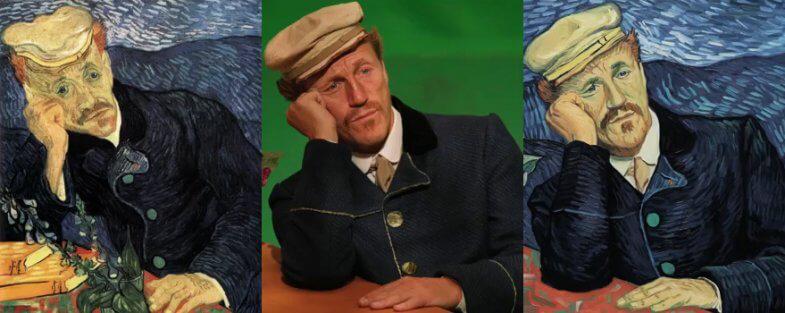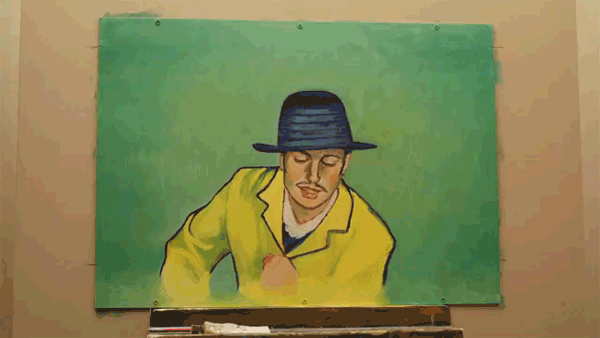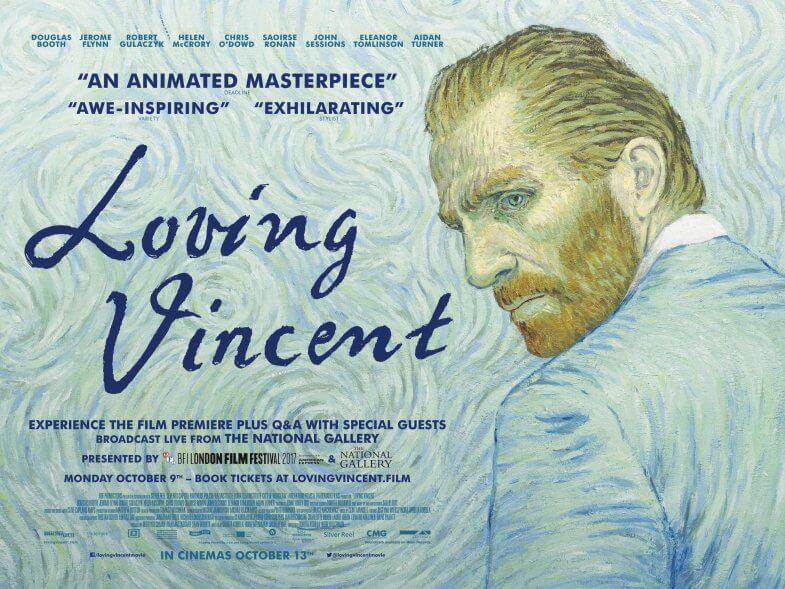‘Loving Vincent’: Interview with Hugh Welchman of BreakThru Films
As an animation producer Hugh Welchman (of BreakThru Films)’s body of work includes the Oscar-winning Peter and the Wolf (Dir. Suzie Templeton, 2006) and Oscar-shortlisted Magic Piano (Dir. Martin Clapp, 2011). Loving Vincent, which Hugh co-directed (with partner and project instigator Dorota Kobiela), co-produced (with BreakThru’s Sean M. Bobbitt and Ivan Mactaggart of Trademark Films) and co-wrote (with Dorota Kobiela and Jacek Dehnel) has had tongues wagging since its successful 2014 Kickstarter campaign introduced animation and art lovers alike to its bold proposition of an entirely oil-painted animated feature, exploring the mysterious and contradictory circumstances of Dutch Post-Impressionist artist Vincent van Gogh’s death while simultaneously evoking his own distinct painterly style.
The final film, having premiered at this year’s Annecy International Festival of Animated Film to a rapturous standing ovation and picking up the Audience Award, boasts not just a fantastic approach to its visual execution made possible by a team of over 130 animators, but a strong and compelling story at its core. With a cast including Douglas Booth, Chris O’Dowd and Robert Gulaczyk as well as an enchanting musical score by Clint Mansell, the film today sees its official UK theatrical release following a UK premiere screening as part of the 61st BFI London Film Festival this past Monday, with upcoming special events including a Masterclass session at the Manchester Animation Festival next month.
Skwigly were privileged to get some time with Hugh following last year’s special preview presentation of the film at Bristol’s Encounters Short Film and Animation Festival.
Can you talk us through how you refined this particular approach to taking on the animation for the film?
There were different approaches that we considered for Loving Vincent. We did some computer animation tests early on. We also thought about doing it in traditional 2D, doing it with acrylic paints on glass, oil paints on glass, and we finally we thought that what looked most Vincent-like was oil paints on canvas, just like his paintings. We also thought, from doing a concept trailer back in 2012, that we could actually set up a kind of studio with a digital infrastructure running underneath whereby we could use very intricate references for the painting animators. So these animators would be able to project the references onto canvas. They’d also have the references at a higher resolution on a screen in front of them as well as an ‘outline’ version.
It’s quite unique in its presentation as a feature, when you consider the aspect ratio and how the each scene is framed, compositionally…
Absolutely. We’re using a format that was used in Hollywood between 1933 and I think 1941, which is a Cinema Academy ratio 1.37:1. The reason we chose this format is that it was the nearest to that of the vast majority of Vincent’s paintings. We wanted things to be as close to the originals as possible, so by having that format as opposed to 16:9 or widescreen we didn’t need to invent more than we had to, in relation to Vincent’s work. Also a lot of the inspirations for us came from film noir, a lot of which are in this format. So we were a fan of the format also, but it was completely down to Vincent’s paintings that we chose it.
As far as replicating the paintings, it was very effective the way the costumes matched up. Was everything tailor-made to purpose in this respect?
Costumes was one of our big departments because we needed the costumes to be as close to the original paintings as possible. In some instances we were able to hire costumes from French costume hire companies, so the Gendarme’s costume and the Postmaster’s costume, for example. But quite a few of the costumes, like Dr. Gachet’s, Pere Tanguy’s or Armand Roulin’s, they’re so stylised in Vincent’s style that we had to make them completely from scratch.

Live-action footage (middle) used as reference for animation painting (right) to evoke Van Gogh’s 1890 Portrait of Dr. Gachet (left)
Obviously its foundation is live-action as far as reference for the performances, how was that as far as directing the actors, knowing how the footage would eventually be treated?
Well the way we put the references together in Loving Vincent is that all the characters were actors shot in live-action against green-screen and blue-screen, and we composited them together with elements from Vincent’s paintings, adding in elements in CG as well. But for us it was really important that the characters were going to be real actors because Vincent painted from life, so we wanted to animate from life. As far as the process of working with the actors, we were incredibly fortunate in that we got just an incredible cast who made the process of the live-action a real joy. The only thing that wasn’t very joyful is that we were having to shoot five minutes a day. We did sixty minutes of material with our main actors in two weeks, whereas on a normal live-action film you’d probably do sixty minutes of material in about four months – so we were shooting at eight times the pace of a regular feature film. That was a challenge, but it was the only way we could make this film, so we and the actors accepted it, that we were doing it under those conditions. The fact that they’re such brilliant actors in their own right meant that it was actually possible to do that.
The sound and dialogue comes across as very authentic, as though it were entirely live-action. Were you able to use much sound as recorded or did it require some additional work?
For the actors it was 95% recorded on-set, there’s been a little bit of ADR, hardly any of it for technical reasons, mainly because after we shot we decided we wanted to change some bits of the story or tweak the edit in some way. The soundscape you hear is completely constructed by Noise Room, a company in Poland that we have been working with from the very beginning. In fact I think Michał Jankowski has been on this longer than me! Not quite as long as Dorota, because that’s impossible, but they’ve been part of the whole idea from the beginning. We wanted to go for very naturalistic sound although there are a couple of dream sequences and we’ve got flashbacks, so we come out of the naturalistic soundscape a little bit there. But we thought that the picture is so colourful and revolutionary that we wanted to have quite a traditional feature film soundscape.
Did you have much of a relationship with historical organisations such as the Van Gogh Museum?
Yeah, I think the Van Gogh Museum were always very curious about what we were doing. They are not a filmmaking company, they are very much into research and van Gogh’s life, so their world is all about 19th century painting. But they were very generous with their time and allowed us access to their scholars, they shared the paintings with us at very, very high resolution so that we could study them. We went and talked to their experts about the techniques that van Gogh used, so yes, they’ve been very open-minded and helpful in this process. We’re very thankful to them for that.

Paint-on-canvas animation process for Loving Vincent
Throughout the film there are these two painterly styles, one very much in the vein of Vincent van Gogh’s while flashback sequences are more reserved and don’t refer to the paintings directly. Is it ultimately the same process as far as how the reference footage is translated to painted animation?
It’s the same steps that we use when we are doing the black-and-white painting animation, but it’s closer to the live-action reference because actually the whole style is meant to look like photographs from that era. So it’s much closer to rotoscoping than the ‘Vincent’ style, because there the references are not followed nearly as closely. Within the lines the painters have to come up with a whole concept of how they’re doing the van Gogh brushstrokes, so it’s much more animation-orientated in the van Gogh sections than it is in the flashback sections that look very close to live-action.
Can you elaborate on how a project this ambitious was able to get off the ground?
A third of the film was financed by pre-sales to different territories. We sold it very early on to France and Asian and Middle-Eastern territories and we also had a bank loan against those sales and future sales, but I would say that the real core of our funding came from wealthy individuals who are passionate about Vincent van Gogh. Out of 300-odd meetings we found four or five people who are really incredibly passionate about Van Gogh and what we were trying to do. The whole process was started with media development funds and with money from the Polish Film Institute. We actually had the city of Wrocław as a co-producer; as the European Capital of Culture in 2016 it became our co-producer on the project and has been incredibly supportive throughout.

Loving Vincent UK poster
What are your hopes for the film?
My aim is that as many people as possible in the world will see it. I myself am a convert to Vincent’s painting and to art in general. I very rarely ever went to art galleries before I started this project and it’s really opened my eyes to the fact that, if you just give it a chance, great art can be a valuable part of your life experience. So I hope the film will make people want to see Vincent’s work, read his letters. Also it’s meant to be fun, it’s a bit of a crime thriller, it looks like nothing else that you’re going to see in the cinema, so I hope that people will be amazed by what they see and interested by the story.
Loving Vincent is out in UK cinemas today. For more info and international listings visit the official site at lovingvincent.com

